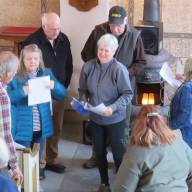Across Vermont, many school districts are facing the same challenge we see in Harwood Unified Union School District (HUUSD): aging facilities, limited funding, and the need for careful, community-based planning. Added to this is the uncertainty created by Vermont’s Act 73 and the possibility of statewide school redistricting, both of which may influence how districts organize and use their buildings in the years ahead.
While our schools have kept the facilities in the best shape possible on a limited budget, decades of deferred maintenance and rising construction costs have brought us to a point where long-term planning is no longer optional. It is essential.
The school board began a facilities planning process with the architectural firm TruexsCullins last fall to help us better understand the condition, capacity, and long-term needs of our buildings. While efforts in the last few years focused specifically on Harwood Union High School, the intent of this process was to understand how to best use and maintain the other buildings in the school district. Last year the planning process focused on the study of building usage, capacity, and future options for each facility.
This summer, the school board continued the planning process which involved comprehensive facility evaluations, including document review, site visits, engineering and architectural assessments, and the development of a detailed spreadsheet of maintenance priorities with estimated costs.
Recommendations were categorized by urgency ranging from health and safety to energy efficiency and functional upgrades, and Facility Condition Index scores were calculated for each school.
This sequential phase built on prior work, documenting how our schools are currently used and how spaces could be adapted to better meet student needs. The findings from this summer’s study provide critical information to guide near-term decision-making while laying the groundwork for deeper planning in the future.
In an ideal situation, districts complete a full master plan that takes two years or more and includes both a districtwide study and then an individual school level plan at the time of renovations.
Our process, by necessity, is more abbreviated due to cost, timing, and local context. The school board is concentrating on the most immediate and high-impact information, while positioning the district to expand planning efforts as resources and circumstances allow.
Having been involved in several large-scale renovation and construction projects earlier in my career as a superintendent, I understand how complex this work can be when done thoroughly and transparently.
The most successful projects begin with community participation and a shared understanding of needs, values, and trade-offs. That is the phase we are in now: gathering information, listening to community input, and identifying priorities that reflect what matters most to our students, staff, and residents.
There is no hidden agenda in this process. The goal is to understand the condition and capacity of our facilities, to plan responsibly for the future, and to ensure that our schools remain safe, welcoming, and educationally effective for years to come.
I invite all community members to join or tune in to the school board meeting on Wednesday, October 22, at 6 p.m. at Harwood Union High School, where TruexCullins will share their findings from the summer study.
Your voice matters. Vermont communities have always valued open conversation and practical problem solving, and this is a moment when both are especially needed. Together, we can ensure that the facilities serving our children today will continue to serve the next generation of students with pride and purpose.
Leichliter is the superintendent of schools at the HUUSD.
You might also like












